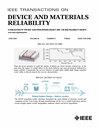21%高效柔性钙钛矿太阳能电池凹、凸、正弦弯曲可靠性试验
IF 2.5
3区 工程技术
Q2 ENGINEERING, ELECTRICAL & ELECTRONIC
IEEE Transactions on Device and Materials Reliability
Pub Date : 2023-06-05
DOI:10.1109/TDMR.2023.3282641
引用次数: 2
摘要
钙钛矿太阳能电池(PSCs)被认为是光伏(PV)技术的新星。然而,灵活性是psc限制可穿戴应用潜力的主要限制因素。因此,本文报道了柔性psc (F-PSC)设计,并使用Silvaco-TCAD工具进行了仿真。不同的弯曲模式,如凹、凸、正弦,包括平面结构,已经被报道来检查所提出的设备的性能。研究和分析了弯曲半径(5 ~ 20mm)和弯曲幅度(0.5 ~ 2mm)对F-PSC器件性能的影响。结果表明,平面F-PSC具有较高的PV参数:短路电流密度(JSC)为21.9 mA/cm2,开路电压(VOC)为1.18 V,填充因子(FF)为79.31%,PCE为20.5%。得到了PV参数、JV和EQE特性的仿真结果。该研究结果将为探索具有更好弯曲性能的F-PSC性能提供重要的方法。本文章由计算机程序翻译,如有差异,请以英文原文为准。
Reliability Test of 21% Efficient Flexible Perovskite Solar Cell Under Concave, Convex and Sinusoidal Bending
Perovskite solar cells (PSCs) have been considered the new rising star in photovoltaic (PV) technology. However, flexibility is the major limiting factor in PSCs for restraining the potential for wearable applications. Therefore, the flexible-PSC (F-PSC) design is reported and simulated using the Silvaco-TCAD tool. Different bending modes, such as concave, convex, and sinusoidal, including planar structure, have been reported to examine the performance of the proposed device. The influence of bending radius (5 to 20 mm) and bending amplitude (0.5 to 2 mm) is studied and analyzed to optimize the performance of the F-PSC device. It has been obtained that the planar F-PSC delivers higher PV parameters: short-circuit current density (JSC) of 21.9 mA/cm2, open-circuit voltage (VOC) of 1.18 V, fill factor (FF) of 79.31% and PCE of 20.5%. Simulated results are obtained regarding PV parameters, JV, and EQE characteristics. The findings of the reported study would significantly provide a way to explore the F-PSC performance with better-bending properties.
求助全文
通过发布文献求助,成功后即可免费获取论文全文。
去求助
来源期刊

IEEE Transactions on Device and Materials Reliability
工程技术-工程:电子与电气
CiteScore
4.80
自引率
5.00%
发文量
71
审稿时长
6-12 weeks
期刊介绍:
The scope of the publication includes, but is not limited to Reliability of: Devices, Materials, Processes, Interfaces, Integrated Microsystems (including MEMS & Sensors), Transistors, Technology (CMOS, BiCMOS, etc.), Integrated Circuits (IC, SSI, MSI, LSI, ULSI, ELSI, etc.), Thin Film Transistor Applications. The measurement and understanding of the reliability of such entities at each phase, from the concept stage through research and development and into manufacturing scale-up, provides the overall database on the reliability of the devices, materials, processes, package and other necessities for the successful introduction of a product to market. This reliability database is the foundation for a quality product, which meets customer expectation. A product so developed has high reliability. High quality will be achieved because product weaknesses will have been found (root cause analysis) and designed out of the final product. This process of ever increasing reliability and quality will result in a superior product. In the end, reliability and quality are not one thing; but in a sense everything, which can be or has to be done to guarantee that the product successfully performs in the field under customer conditions. Our goal is to capture these advances. An additional objective is to focus cross fertilized communication in the state of the art of reliability of electronic materials and devices and provide fundamental understanding of basic phenomena that affect reliability. In addition, the publication is a forum for interdisciplinary studies on reliability. An overall goal is to provide leading edge/state of the art information, which is critically relevant to the creation of reliable products.
 求助内容:
求助内容: 应助结果提醒方式:
应助结果提醒方式:


